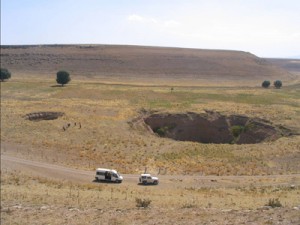Archaeological Study of a Limestone Sinkhole:
In partnership with the East National Park of the Dominican Republic, a team of archaeologists and scientists led by Charles D.Beeker of Indiana University has provided an initial evaluation of a mysterious sinkhole in the tropical jungle. During three separate expeditions in 1996, the team was able to penetrate and document the archaeological potential of El Manantial de la Aleta, a deep, fresh water well containing a rich deposit of Taino artifacts.
This site has been an important landscape feature for many centuries. It is thought to be the water source described by the chronicler Bartoleme de Las Casas in the first decade of the sixteenth century for the capital village
of Cotubanama, the Taino cacique. This site and its people were destroyed in a bloody war with the Spaniards in 1503.
The La Aleta site lies deep in the jungle of East National Park far from any established roads. There is a trail which can be taken from Boca de Yuma through La Granchorra, but it is very difficult. The team assembled several
tons of diving supplies and equipment needed to conduct the archaeological study. Some items were transported by mule over a 7 hour trail. Other materials and team members were flown by helicopter to the site. The first order of business was to get to the water. The manantial, or sinkhole, is reached by a descent of 50 feet through a small opening in the limestone rock. A rope system was rigged to allow access and equipment to reach the water. A 14 foot Quicksilver inflatable was launched and served as a diving platform for the operation.
La Aleta proved to be a spectacular dive. It has crystal clear water at the surface, but at a depth of 35 feet, a sulfur layer is encountered. This mixture continues to a depth of 65 feet, where fresh water again takes over. The bottom is at a depth of 115 feet. Here a cap rock, part of the collapsed formations from above, serves as a datum for the site. Thick humus silt containing a variety of artifacts, surrounds the cap rock. The deposit slopes to great depth — at least 240 feet in every directions.
